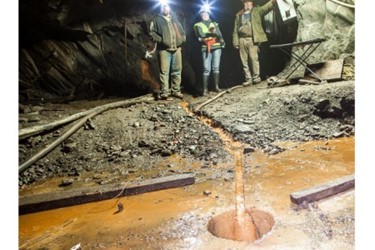Water Inflow System Proves Effective

Installed in 2016, Sanford Lab's new water inflow control system passed its first major test during heavy rainfalls this July
Sanford Underground Research Facility’s (Sanford Lab) new water inflow control system, installed in 2016, passed its first major test this July when nearly three inches of rain doused the Black Hills area in just one week.
“The significant moisture this year would have prevented underground access in the past,” said Mike Headley, executive director of Sanford Lab. “It’s great to see the work our team put into this system pay off in improved access for science and construction activities.”
When it rains, the Open Cut in Lead, South Dakota, acts as an oversized funnel, channeling a lot of water to levels deep underground. The water eventually collects in a deep pool—at about 5,700 feet below the surface—then must be pumped out to ensure safe access to underground laboratories. During heavy rain events in the past, the increased water inflow had curtailed access to the underground levels until pumping systems could catch up.
That all changed with the completion of the water inflow project. The new system diverts water that would normally fall to lower levels to a pump room on the 2450 Level. Now, up to 2,000 gallons per minute of cool, clean water are captured, and remaining inflows are directed down 5 Shaft to a collection pool on the 2000 Level. When the region received 2.48 inches of rain in the first week of July, alone—almost as much as the area’s average for the entire month of July—the new system proved itself.
“Prior to the completion of the water inflow project, the rain events like we’ve seen in 2019 would've restricted access a couple different times for a minimum of a week, maybe longer,” said Bryce Pietzyk, underground access director at Sanford Lab.
“The system worked. We were able to keep researchers, contractors and infrastructure technicians working,” said Pietzyk. “We needed a solution to get water away from the lab footprint, and that's exactly what this project did.”
It turns out, the system is also environmentally and economically smart. Pumping water to the surface from the lowest levels of the facility requires five different pumping stages. However, only two pumps must be used for the water collected at higher levels. This system drastically reduces the energy expended to pump water, resulting in energy and monetary savings for the facility.
“We are capturing two-thirds to one-half of the water infiltrating to the underground during heavy rain events before it reaches lower levels,” said Ken Noren, foreman of the Waste Water Treatment Plant (WWTP).
The project also increased the efficiency of the WWTP. In order to maintain a healthy ecosystem in Gold Run Creek, the water discharged from the WWTP must be below seventy-five degrees. Water collected at higher levels of the underground averages between 48 and 52 degrees and can be mixed with the hot water pumped from the lower levels before it is treated and discharged.
“The major benefit that I see is that this system provides a constant flow of water that I can count on to keep the water treatment systems running,” said Noren.
The water inflow project was a major undertaking, requiring maintenance work on three different levels, the installment of large concrete water walls and the drilling of a 300-foot borehole.
“The project was a challenge. We had to do rehabilitation on the levels before bringing large machinery in. The project included hauling pipe down long drifts and sometimes mixing fifty-pound bags of concrete by hand,” said Luke Scott, infrastructure technician and task lead of the water inflow project. “It was a team effort, for sure. Everyone on the UMC had a hand in the work.”
Pietzyk said the team will continue to monitor the water inflow system and upgrade when necessary.
Source: Sanford Underground Research Facility
